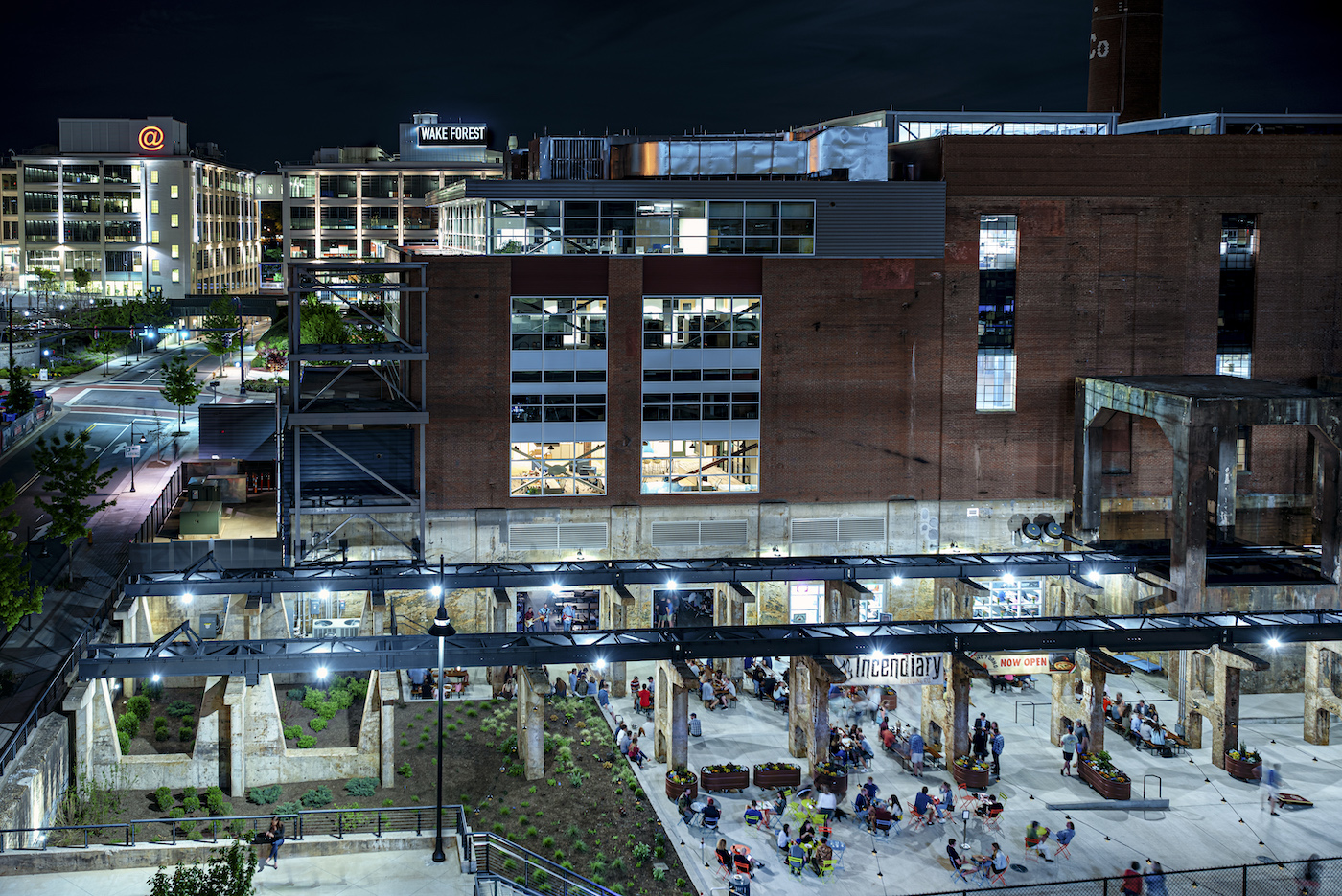Mixed-use developments can come in many different shapes and sizes. Some may be small, like a corner store with apartments above it, while others may be large-scale developments that include office space, retail space and residential units all in one complex. No matter the size or scope, all mixed-use developments have one thing in common: they’re designed to create a more vibrant and cohesive community by bringing together different uses in one space.
Innovation Districts: Mixed-use Development Projects 2.0

One type of mixed-use development is the live-work-play model, which includes residential, office and retail space all in one complex. Sound familiar?
Innovation districts, like the Innovation Quarter, embody the live-work-play model, creating densely-populated urban environments with a mix of spaces and amenities that encourage interaction and collaboration. These districts are designed to promote creativity and synergy while attracting and retaining talent. When people with different perspectives, backgrounds and disciplines work together in close proximity, they have more opportunities to come up with innovative, problem-solving solutions.
Innovation districts also maximize the benefits of mixed-use development:
- Commercial and retail establishments in mixed-use developments can get more foot traffic. Businesses may also see recurring patronage from those who live and work within the innovation district.
- Mixed-use developments with people living in close proximity to one another can lead to a greater sense of community. Successful innovation districts reinforce connections by leveraging programming, which brings people together around shared interests, and placemaking, which encourages organic social interaction.
- Because they are compact, mixed-use developments can be a more efficient use of land and infrastructure. Similarly, innovation districts are meticulously planned to have a greater variety of complementary uses, making them more livable and attractive to a broader range of people.
Some of the Best Mixed Use Development Projects We’ve Seen
There is no one-size-fits-all answer to whether innovation districts are the best mixed-use development projects. Each situation is unique, and the best approach depends on the specific goals and needs of the community. However, innovation districts often have the potential to promote economic development and growth while also creating more livable and sustainable communities. Here are some impressive examples:
South Lake Union in Seattle, Washington
South Lake Union (SLU) is a vibrant, mixed-use neighborhood in the heart of Seattle. The rapid transformation of SLU from a run-down warehouse district to a thriving community has been led by Vulcan Real Estate, a company owned by Microsoft co-founder Paul Allen. The University of Washington’s medical and bioscience campus and the Fred Hutchinson Cancer Research Center are key anchors fueling groundbreaking innovation in the healthcare and life science industries.
Today, SLU is a vibrant community with a rich culture and a commitment to innovation. The neighborhood is home to a diverse mix of retail businesses, restaurants, LEED-certified office buildings, condominiums and apartments—all designed with an emphasis on walkability, public transportation and sustainability. Public art, 170 acres of parks and historic buildings provide tranquility and a sense of place.


Pittsburgh Innovation District in Pittsburgh, Pennsylvania
The Pittsburgh Innovation District is a vibrant hub of business, research and technology in Pittsburgh’s Oakland neighborhood. The presence of industry leaders coupled with lifestyle amenities all within a public transit hub makes the innovation district one-of-a-kind. Founded in 2017, the district’s mission is to unify the critical mass of talent, university resources, transformative technology and cultural assets in the Oakland neighborhood to create a sustainable innovation ecosystem with global impact.
The Pittsburgh Innovation District is home to several colleges and universities, cutting-edge medical centers and world-renowned cultural institutions. Its location and amenities make it an ideal environment for businesses and entrepreneurs to thrive. With over $1 billion in university research and development (R&D) funding, researchers and scientists in Pittsburgh outperform the national average of scholarly publications in fields like robotics, gerontology, critical care, artificial intelligence, cell tissue engineering, neurotrauma and software.


Cortex Innovation Community in St. Louis, Missouri
Cortex Innovation Community was founded in 2002 as a collaboration between Washington University in St. Louis, BJC HealthCare, the University of Missouri – St. Louis, Saint Louis University and the Missouri Botanical Garden. Its mission is to serve as an inclusive economic engine for the St. Louis region through high-quality facilities, programs that build knowledge and networks, and partnerships that support emerging and established companies.
The 200-acre urban innovation hub is currently home to over 415 companies and 5,800 employees and has generated $2.1 billion in economic output impacts for the region to date. Cortex’s future plans include a MetroLink light-rail station, a major highway interchange and a publicly accessible park. The development will reach an estimated total of $2.3 billion; however, it’s expected that 15,000 permanent jobs will be added to the region as a result.


uCity Square in Philadelphia, Pennsylvania
uCity Square is an 8.0 million-square-foot mixed-use community located in Philadelphia’s University City neighborhood. Surrounded by colleges, universities, independent research institutions, world-renowned hospitals and hundreds of restaurants and shops, uCity Square is where serendipitous collisions and chance meetings lead to collaboration and the exchange of ideas. The Science Center, which is the physical and spiritual heart of uCity Square, was founded in 1963 as the nation’s first urban research park. Its core strength in tech-based economic development makes it a powerhouse entrepreneurial commercialization in the region.
Wexford Science + Technology, the Innovation Quarter’s partner in real estate and development, has been developing lab space in the Philadelphia’s University City neighborhood since 1999. Wexford’s partnership with uCity Square has created a vibrant, mixed-use, amenity-rich area focused on driving research, discovery, innovation, entrepreneurial activity, corporate engagement and community inclusion.


Mixed-use Development Bringing Innovation to the Forefront
Innovation districts are some of the country’s most successful mixed-use development projects. By bringing together a variety of uses in one area, these districts promote a sense of community and provide opportunities for people to live, work and play in close proximity. This mix creates a vibrant and exciting environment that’s perfect for creativity, collaboration and innovation.




